How the power of the Minions and Gen Z propelled the ‘Despicable Me’ franchise
Published 3:00 am Wednesday, July 24, 2024

- Minions in a scene from “Despicable Me 4.”
It was a spectacle (and for some, a menace) when droves of suit-clad young men showed up to theaters for 2022’s “Minions: The Rise of Gru.”
Against all odds, the #Gentleminions social media phenomenon showed that the Minions — up until that point, a staple of Facebook memes shared by very-online moms — could evolve as a cultural touchstone for that coveted demographic, Gen Z. The Minions had come full circle, staying relevant to the children who first met the yellow mischief-makers in 2010’s “Despicable Me” all the way through their young adult years.
It’s the kind of organic marketing that studios and theater owners can only dream of. Universal Pictures and Illumination Entertainment are counting on that multigenerational popularity to propel the franchise’s latest installment, “Despicable Me 4.”
The last “Minions” movie broke Fourth of July domestic box-office records and went on to make $940 million worldwide. This time around, families are already primed to hit the theaters with the recent success of Pixar’s “Inside Out 2.”
The cross-generational popularity of the Minions stems from their cute appearances and humorous antics. But part of the appeal is also that they’re a bit of a blank slate, said Carrie Wilson-Brown, an instructor at the University of Illinois’ College of Media. In the same way that Sanrio icon Hello Kitty has advertised both motor oil and diamond necklaces and regularly wears all teams’ baseball caps, the Minions have become a canvas on which you can project whatever you want.
Minions are on all manner of merchandise these days. There are Minion Chia pets, Minion mugs, Minion sandwich makers and Minion toasters. For Los Angeles residents, there’s even the giant Minion that peeks over the edge of a Universal Studios parking structure to spy on the 101 Freeway (which has spawned memes of its own).
“You can infer anything out of it,” Wilson-Brown said. “They can even travel culturally, not from generation to generation, but from country to country because they don’t speak a particular language.”
It’s how the Minions joined the front lines of Facebook mom memes, which typically pair a picture of a Minion with unrelated sayings such as “I didn’t fall, the floor just needed a hug” or “I’ve been hiding from exercise. I’m in the fitness protection program.”
But the #Gentleminions craze was a turning point when Gen Z consumers tried to take back the Minions of their childhood.
Companies face a delicate dance while trying to court Gen Z audiences, who have expendable income they’re willing to plunk down on pop culture merchandise. Try too hard to appeal to them, and it seems inauthentic; try too little, and it looks like the product isn’t actually meant for them.
“Film companies and traditional media are desperately trying to constantly see what Gen Z-ers are producing in a cultural milieu, but in many respects they’re trailing behind them,” Wilson-Brown said.





